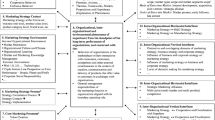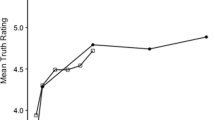Abstract
Information markets are typically used as prediction tools, aggregating opinions about the likelihood of future events, or as preference indicators, identifying participants’ product preferences. However, the basic information market concept is more widely applicable. In our experiment, we utilized information markets within the domains of idea generation and group decisioning. Participants were allowed to propose ideas regarding potential technology research areas; these ideas were represented as securities on a virtual financial market. Participants were able to trade shares of technology ideas over the course of 3 weeks, resulting in the market identifying the “best” idea as the highest priced security. Our findings suggest that information markets for idea generation result in more ideas and more participants than traditional idea generation techniques; however, using markets to rank ideas may be no better than other methods of idea ranking. Additional benefits include providing immediate feedback, allowing visibility of all ideas to all contributors, and being a fun mechanism for consensus building.
Similar content being viewed by others
References
Bell, T. (2002). Gambling for the good, trading for the future: The legality of markets in science claims. Vol. 5 Chapman Law Review.
Berg, J., Forsythe, R., Nelson, F., & Reitz, T. (2005) Results from a dozen years of election futures markets research. In The handbook of experimental economics results, Available at http://www.biz.uiowa.edu/eim/archive/BFNR_2000.pdf.
Bingham, A. (2003). Complexity theory and pharmaceutical R&D. Boston: Credit Suisse First.
Chan, N., Dahan, E., Kim, A., Lo, A., & Poggio, T. (2002). Securities trading of concepts. In Massachusetts Institute of Technology technical report, Cambridge, MA.
Chan, N., Dahan, E., Lo, A., & Poggio, T. (2001). Experimental markets for product concepts. In Massachusetts Institute of Technology technical report, Cambridge, MA.
Chen, K., & Plott, C. (2002). Information aggregation mechanisms concept, design and implementation for a sales forecasting problem. In Social Science working paper 1131, Pasadena, California. California Institute of Technology.
Feder, B. J. (2002). To learn what people want, trade ‘idea stocks’. The New York Times, Business, p. B4. February 10.
Forsythe, R., & Lundholm, R. (1990). Information aggregation in an experimental market. Econometrica, 58(2), 309–347.
Forsythe, R., Reitz, T., & Ross, T. (1999). Wishes, expectations, and actions: A survey on price formation in election stock markets. Journal of Economic Behavior and Organization, 39, 83–110.
Gruca, T., Berg, J., & Cipriano, M. (2003). The effect of electronic markets on forecasts of new product success. Information Systems Frontiers, 5(1), 95–105.
Hanson, R. (2005). Foul play in information markets. In B. Hahn & P. Tetlock (Eds.), Information markets: A new way of making decisions in the public and private sectors. AEI-Brookings.
Hapgood, F. (2004). Future shock. CMO Magazine. September.
Hender, J., Rodgers, T., Dean, D., & Nunamaker, J. (2001). Improving group creativity: Brainstorming versus non-brainstorming techniques in a GSS environment. In Proceedings of the 34th Annual Hawaii International Conference on System Sciences (HICSS-34)—Vol. 1.
Isaksen, S. G. (1998). A review of brainstorming research: Six critical issues for inquiry. Creativity Research Unit—Monograph #302. Buffalo, NY: Creative Problem Solving Group—Buffalo.
James, D., & Issac, R. M. (2000). Asset markets: How they are affected by tournament incentives for individuals. American Economic Review, 90, 995–1004.
Kambil, A. (2002). Leading with an invisible hand. Outlook, no. 2. p. 20–25.
Kivat, B. (2004). The end of management? And looking ahead, time, inside business. p. A4, July 12.
LaComb, C., Barnett, J., & Pan, Q. (2005). Designing information markets. In GE Global Research Center technical report.
Linstone, H., & Turoff, M. (2002). The Delphi method: Techniques and applications. Boston: Addison-Wesley.
Nunamaker, J. F., Briggs, R., Mittleman, D., Vogel, D., & Balthazard, P. (1996–1997). Lessons from a dozen years of group support systems research: A discussion of lab and field findings. Journal of Management Information Systems, 13(3), 163–207.
O’Hara, M. (1995). Market microstructure theory. Malden: Blackwell.
Pennock, D., Debnath, S., Glover, E., & Giles, C. (2002). Modeling information incorporation in markets, with application to detecting and explaining events. In Proceedings of the Eighteenth Conference on Uncertainty in Artificial Intelligence.
Pennock, D., Lawrence, S., Giles, C., & Nielsen, F. (2001a). The real power of artificial markets. Science, 291, 987–988, February.
Pennock, D., Lawrence, S., Giles, L., & Nielsen, F. (2001b). The power of play: Efficiency and forecast accuracy in web market games. In Institute for Operations Research and the Management Sciences National Meeting. Miami, FL November.
Plott, C., & Sunder, S. (1988). Rational expectations and the aggregation of diverse information in laboratory security markets. Econometrica, 56(5), 1085–1118.
Servan-Schreiber, E., Wolfers, J., Pennock, D., & Galebach, B. (2004). Prediction markets: Does money matter. Electronic Markets, 14(3).
Sunstein, C. (2004). Group judgments: Deliberations, statistical means, and information markets. AEI-Brookings Joint Center for Regulatory Studies Working Paper.
Welch, J. F., & Byrne, J. A. (2001). Jack: Straight from the gut. New York, NY: Warner Books.
Wolfers, J., & Zitzewitz, E. (2004). Prediction markets. Stanford GSB Research paper no. 1854. Retrieved from http://ssrn.com/abstract=560070.
Author information
Authors and Affiliations
Corresponding author
Rights and permissions
About this article
Cite this article
LaComb, C.A., Barnett, J.A. & Pan, Q. The imagination market. Inf Syst Front 9, 245–256 (2007). https://doi.org/10.1007/s10796-007-9024-9
Received:
Accepted:
Published:
Issue Date:
DOI: https://doi.org/10.1007/s10796-007-9024-9




